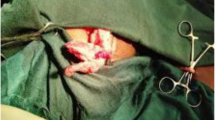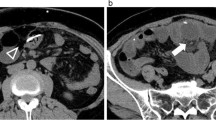Abstract
Objective
In spite of the recent interest in endoscopic third ventriculostomy, ventriculoperitoneal (VP) shunt is still the gold standard in treating non-obstructive hydrocephalus in children. The peritoneal cavity remains the optimal site for cerebrospinal fluid (CSF) diversion. Shunt insertion and re-interventions carry a high risk of inaesthetic abdominal scars and long-term morbidity. We report a technique of transumbilical shunt insertion, which provides better cosmetic results and without many more complications. This approach has been performed for a long period in a wide variety of intra-abdominal conditions by pediatric surgeons.
Methods
Between March and October 2003, we inserted 12 VP shunts in children. For eight consecutively treated children the follow-up is more than 3 months. All the shunts were inserted through the umbilicus. These eight children are the subjects of this study. Indications for shunting were: communicating hydrocephalus (6 cases), subdural hematoma (1 case), and hygroma associated with an arachnoid cyst (1 case). The population consisted of 7 boys and 1 girl, ranging in age between 6 weeks and 47 months (mean age: 15 months), and their body weights varied between 2,110 g and 18,000 g (mean weight: 8,470 g). All children were examined twice a day for 3 days, and wounds were examined daily to check for the absence of sepsis or dehiscence. Clinical controls were performed 1 month after discharge. The operating surgeon was invited to comment on any difficulties encountered in making or closing this incision afterwards.
Results
The average length of clinical follow-up was 6 months (range 4–7 months). One infection of the VP shunt occurred. It was treated with external drainage and antibiotics. After 1 week, a second VP shunt was inserted using the same technique without particular difficulty and with a nice cosmetic result. Concerning the seven other children, the cosmetic results were optimal, with no puckered abdominal scars or wound dehiscence, and with no perioperative or long-term complications related to the umbilical approach.
Conclusion
At this early follow-up, umbilical incision for shunt insertion is a safe and easy technique. It provides an optimal cosmetic result, even in cases of re-intervention. This minimally invasive surgery does not require long specialized training. We have not shown an increase in complications associated with a “learning curve.” Longer follow-up is needed to evaluate the risk of infection.





Similar content being viewed by others
References
Begin GF (1993) Appendectomy in children by simple port laparoscopy [in French]. Chir Endosc 2:6–9
Begin GF (1993) Creation du pneumoperitoine sous contrôle visuel. J Coelio Chir 5:18–20
Buanes T, Mjaland O (1996) Complications in laparoscopic and open cholecystectomy: a prospective comparative trial. Surg Laparosc Endosc 6:266–272
Caleel RT (2000) Trans-umbilical endoscopic breast augmentation: submammary and subpectoral. Plast Reconstr Surg 106:1177–1182
Choi S, McComb JG, Levy ML, Gonzalez-Gomez I, Baysrton R (2003) Use of elemental iodine for shunt infection prophylaxis. Neurosurgery 52:908–912
Drake JM, Iantosca MR (2001) Management of pediatric hydrocephalus with shunts. In: McLone DG (ed) Pediatric neurosurgery. Surgery of the developing nervous system, 4th edn. Saunders, Philadelphia, pp 505–522
Georgeson KE, Owings E (2000) Advances in minimally invasive surgery in children. Am J Surg 180:362–364
McGirt MJ, Zaas A, Fuchs HE, George TM, Kaye K, Sexton DJ (2003) Risk factors for pediatric ventriculoperitoneal shunt infection and predictors of infectious pathogens. Clin Infect Dis 36:858–862
Paes TRF, Stoker DL, Morecroft Ng, Morecroft J (1987) Circumumbilical versus trans-umbilical abdominal incision. Br J Surg 74:822–823
Plattner V, Raffaitin P, Mirallie E, Legus C, Heloury Y (1997) Appendicites compliquées de l’enfant: laparoscopie ou MacBurney? Ann Chir Paris 51:990–994
Poli-Merol ML, François S, Lefevre F, Bouche Pillon-Persyn MA, Lefort G, Daoud S (1996) Interest of umbilical fold incision for pyloromyotomy. Eur J Pediatr Surg 6:13–14
Soutter AD, Askew AA (2003) Trans-umbilical laparotomy in infants: a novel approach for a wide variety of surgical disease. J Pediatr Surg 38:950–952
Tan KC, Bianchi A (1986) Circumumbilical incision for pyloromyotomy. Br J Surg 73:339
Valla JS, Ordorica-Flores RM, Steyart H, Merrot T, Bartels AM, Breaud J, Ginier C, Cheli M (1999) Umbilical one-puncture laparoscopic-assisted appendectomy in children. Surg Endosc 13:83–85
Author information
Authors and Affiliations
Corresponding author
Rights and permissions
About this article
Cite this article
Scavarda, D., Breaud, J., Khalil, M. et al. Transumbilical approach for shunt insertion in the pediatric population: an improvement in cosmetic results. Childs Nerv Syst 21, 39–43 (2005). https://doi.org/10.1007/s00381-004-1028-x
Received:
Published:
Issue Date:
DOI: https://doi.org/10.1007/s00381-004-1028-x




